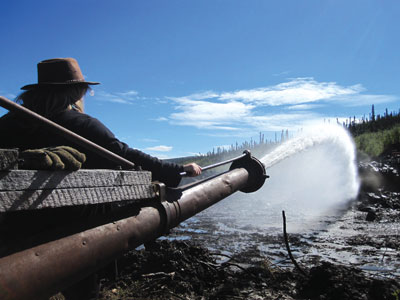
Placer gold mining operations in the Yukon use powerful, diesel pump-driven water jets called hydraulic monitors to excavate alluvial deposits. MTU diesels have been used by some miners since the 1950s.
In 1896, miners discovered gold in the Klondike region of Canada’s Yukon Territory. When the news spread, an estimated 100,000 prospectors flocked to the remote area in what came to be known as the Yukon Gold Rush. They searched for placer gold and some struck it rich, but the vast majority wasn’t so lucky.
The Yukon Gold Rush ended when gold was discovered in Nome, Alaska—but placer mining in the Yukon continued as gold mining methods became more efficient. Heavy-duty hydraulic machinery replaced metal pans and wooden sluices. Powerful water cannons called hydraulic monitors were used to separate the precious material from the deposit.
The new equipment helped small gold mine operations like the Yukon Placer Mining Co. dig deeper and faster. During the 1950s, the company employed a hydraulic monitor powered by a Detroit Diesel 2-Cycle Series 71 engine. At nearby Big Gold Creek, three Series 71 engines powered the generator on a gold dredge. When the operation closed 40 years later, the hydraulic monitor’s engine was still in good shape. Over its lifetime, the six-cylinder engine was reconditioned with a factory short block, but the ancillaries were all original. Jim Lynch, Yukon Placer Mining’s pump operator, said, “The only problem I ever had with the unit was the monitor nozzle was so powerful it would swing around and take off the exhaust stack.”
Even after retirement, the legendary engine lived on. Today, it and the hydraulic monitor unit are on display at the Klondike Gold Dredge Museum in Skagway, Alaska. And, several Series 71-powered machines from the Yukon Placer Mining Company are still in use under different owners—the K-1 Mining Co.
K-1’s four- and six-cylinder Series 71 engines have been in use for more than 25 years, coupled to water pumps outputting up to 3,000 gpm. K1’s four-cylinder unit currently has more than 20,000 hours since needing any significant maintenance work; it’s an early high block that has been producing power since the early 1950s. The six-cylinder engine is a newer (1980s) model. Both machines start, idle and run as new and are competitive with modern engines that run water pumps at 1,800 rpm.
Like other successful gold mining operations in the Yukon Territory, K-1 Mining knows how to work in harsh conditions. Winter temperatures can drop to -60°F., while summer temperatures can reach the high 80s. During mining season, the days are long. “The engines will both run up to 12 hours, day in and day out, to support both development work and production at our mine,” said Mike McDougall, K-1 Mining’s president. “They are steadfastly reliable and easy for our staff to use, which is important due to our remote location. I can’t think of one instance when we have had a shutdown. The engines have kept operating at our mine long after they would have been expected to be replaced.”
K-1 Mining extends the life of its engines with routine maintenance, backed by support from MTU distributor Cullen Diesel Power. “The Detroit Diesel 2-Cycle design is very reliable and rarely needs any maintenance other than regular oil and filter changes,” said McDougall. “When parts are required, they are readily and economically available and the modular design of the engines reduces the inventory we need to keep on hand.”
McDougall finds the ease of maintenance and repair to be a real plus in such a remote site. “Pretty much all maintenance work can be accomplished on site by our own staff. The only downside to our relationship with Cullen is that we often have to re-introduce ourselves to them since our parts purchases are so few and far between.”
While the Yukon Gold Rush lasted only three short years, the area is still rich in gold. K-1 Mining and other small placer gold mines operating in the region have a combined annual production of approximately 100,000 oz. Total Yukon gold production from 1885 to date is about 12.5 million oz, valued at roughly $15 billion at recent prices.
This article was written by Chuck Mahnken on behalf of MTU America. It was originally published in the March 2015 issue of the MTU eReport newsletter.









